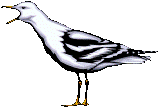Eastern Wildlife Damage Control Conferences
Date of this Version
September 1985
Document Type
Article
Abstract
The endangered classification of the double-crested cormorant (DCC) in Wisconsin resulted in complete protection and significant management efforts in the 1970's., These efforts, probably coupled with reduced pesticide loads, resulted in a resurgence of Wisconsin cormorant populations from a low of 66 pairs in 1972 to 1028 pairs in 1982» The DCC was reclassified as a threatened species in 1982. This apparent success story did not take into consideration the potential negative impact of an abundant piscivorous bird. In 1978 a colony of DCC's became established on a remote rocky island in the Apostle Islands National, Lakeshore, in Lake Superior. From 17 pairs in 1978 the colony increased to 289 pairs in 1985. By 1982, commercial fishermen in the Apostle Islands began to complain about damage to the valuable catch of Lake Whitefish. They accused DCCs of feeding within pound nets and thus causing substantial damage by gilling and scaring captured whitefish. Annual loss was estimated at $5-10,000 distributed amongst 3 fishermen. The interaction of DCC's and the whitefish fishery was studied from 1983-84. Food habits data did not suggest that commercial fish species were important to the diet of DCC's in the Apostle Islands. Observations suggested that the attraction of pound nets centered more on the use of net support poles for perch sites than on the availability of food within the net. Nine abatement techniques were tested. Damage was reduced for periods of up to 4 weeks by a combination of structural modifications that eliminated perching and an old-fashioned scare-crow. National Park Service policy precludes direct control of the increasing DCC population.

